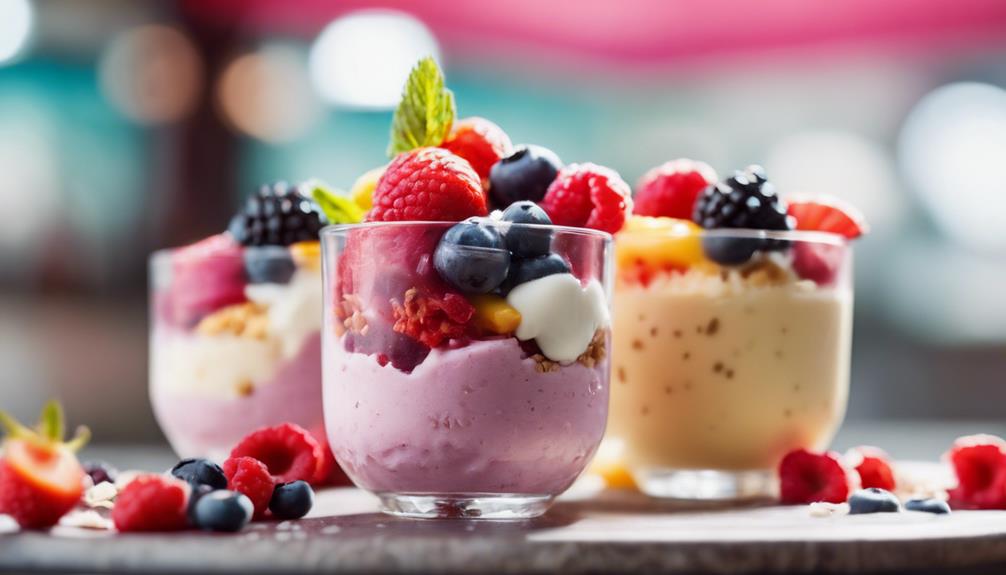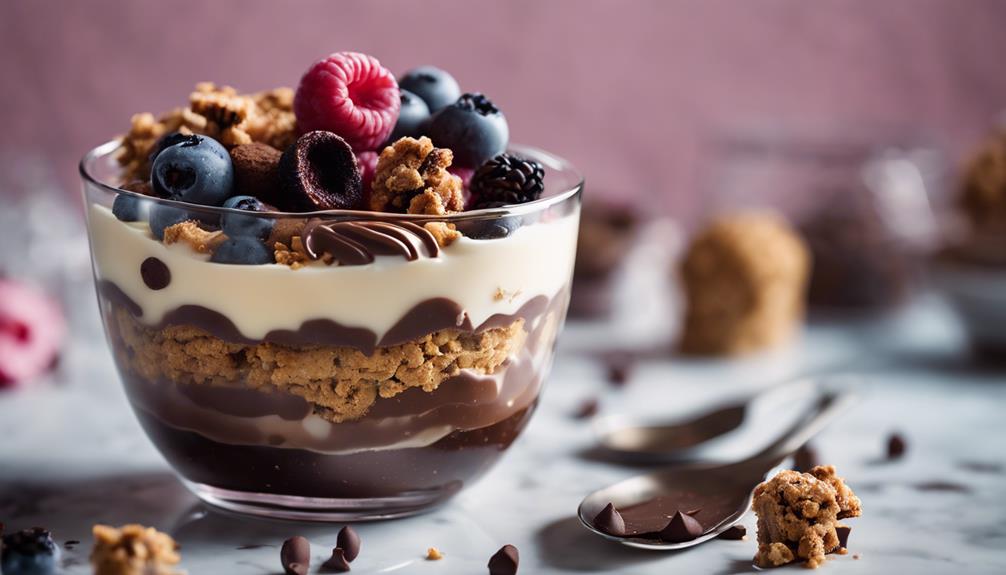Indulging in ice cream can be a delightful treat, offering some health benefits such as calcium and vitamins. However, it is essential to be cautious of the risks – excessive intake of high sugar and fat content could result in weight gain and health issues. Consider exploring healthier options such as non-sugar-added fruit pops or banana ice cream for a lighter choice. It is important to monitor your blood sugar levels, especially if you have diabetes, and be mindful of lactose intolerance. Striking a balance between enjoying ice cream and prioritizing your well-being is crucial.
Key Takeaways
- Ice cream provides calcium, vitamins, and probiotics for bone health and mood-boosting benefits.
- High sugar and fat content may lead to weight gain and blood sugar spikes.
- Limited research on ice cream's health effects warrants caution and moderation.
- Probiotic ice creams support gut health, while lactose-free options reduce digestive discomfort.
- Alternatives like low-sugar fruit pops offer nutrient-dense, lower-calorie options for healthier indulgence.
Ice Cream Nutrition Facts

Exploring the nutritional content of ice cream reveals varying calorie and fat levels depending on the type and ingredients used. Regular vanilla ice cream typically contains around 140 calories and 7g of total fat per serving.
If you opt for premium vanilla ice cream, be prepared for approximately 210 calories and 13g of total fat per serving. On the other hand, low-fat vanilla ice cream offers a lighter option with about 130 calories and 2.5g of total fat per serving.
For those watching their sugar intake, no added sugar vanilla ice cream is a good choice, providing around 115 calories per serving.
When it comes to minerals, most ice creams are high in phosphorus and calcium. However, caution is advised as they're also high in calories and added sugars.
If you're looking to indulge while keeping your calorie and fat intake in check, opting for low-fat or no added sugar varieties might be the way to go.
Health Benefits of Ice Cream

Ice Cream offers a range of potential health benefits, including essential nutrients and mood-boosting properties. This delicious treat contains calcium for strong bones, vitamins A, D, and B12 for overall health, and probiotics for gut health. Additionally, the sugar content in ice cream can provide a quick source of energy, making it a great option for a post-workout treat. Some studies have also suggested that the cold temperature of ice cream can help soothe a sore throat or reduce inflammation. However, it’s important to consume ice cream in moderation, as excessive consumption can lead to negative effects, such as weight gain and increased risk of certain health conditions. Furthermore, some individuals may find that excessive consumption of ice cream can lead to digestive issues, such as ice cream and constipation. It’s important to listen to your body and consume ice cream in a balanced and mindful manner.
The temporary mood boost it provides can uplift your spirits, while aiding in muscle recovery due to its protein content. Ice cream may also contribute to improved bone health, helping to prevent conditions like osteoporosis. Additionally, the quick energy it offers can be beneficial for those needing a pick-me-up.
Different types of ice cream cater to various dietary preferences and energy needs, making it a versatile treat. When enjoyed in moderation, ice cream can be a part of a balanced diet, providing both enjoyment and potential health benefits.
Risks of Ice Cream Consumption

When enjoying ice cream, you should be aware of the health risks it can pose. High sugar and fat content in ice cream may lead to weight gain and health issues if consumed excessively.
Practicing moderation is crucial to avoid potential negative impacts on your well-being.
Health Risks Overview
Consuming ice cream poses health risks due to its high sugar and fat content, potentially leading to weight gain and various health issues. The added sugar and high fat content in ice cream can contribute to an increase in calorie intake, which may lead to weight gain over time if consumed excessively. Portion control is vital to manage these risks and enjoy ice cream in moderation.
Individuals with lactose intolerance should be cautious, as ice cream can cause digestive issues due to its dairy content. Additionally, being aware of the ingredients in ice cream is essential, as some additives may trigger allergic reactions in sensitive individuals.
In addition, improper storage or handling of ice cream can lead to Listeria contamination, posing a risk to health. To minimize these risks, it's important to be mindful of consumption patterns and opt for healthier alternatives when possible.
Sugar and Fat Content
Given the health risks associated with the sugar and fat content in ice cream, it's important to be mindful of the potential negative effects of its consumption on your overall well-being. Ice cream can be high in added sugars, leading to sugar crashes and increasing the risk of health issues like obesity and diabetes. Similarly, the saturated fats in ice cream, when consumed excessively, can displace healthier food choices in your diet and contribute to weight gain. To mitigate these risks, it's crucial to consume foods high in added sugar and saturated fat, like some ice creams, in moderation. Watch out for portion sizes and opt for ice cream options with less added sugar and fewer calories to minimize the potential health risks associated with its sugar and fat content.
| Aspects | Details | Risks |
|---|---|---|
| Sugar Content | High in added sugars | Sugar crashes, obesity, diabetes |
| Fat Content | Rich in saturated fats | Weight gain, unhealthy diet displacement |
| Portion Sizes | Control intake for moderation | Prevent negative health effects |
Moderation Recommendations
To minimize potential health risks associated with ice cream consumption, moderation is key. Consuming ice cream in excess can lead to health risks such as weight gain and high sugar intake, which may result in digestive issues, blood sugar spikes, and potential allergic reactions.
It's essential to practice portion control and opt for healthier ice cream options to mitigate these risks. By being mindful of ingredients, portion sizes, and overall diet, you can better manage the potential negative effects of eating ice cream.
Balancing indulgence with nutritious choices and considering individual dietary restrictions are vital for responsibly enjoying ice cream. Remember that moderation is key in enjoying ice cream without compromising your health.
Make informed choices, practice responsible indulgence, and prioritize your well-being when it comes to ice cream consumption.
Healthy Ice Cream Alternatives

For healthier options than traditional ice cream, consider trying these alternative frozen treats.
- Non-Sugar-Added Frozen Fruit Pops: These popsicles provide a revitalizing and low-calorie alternative to traditional ice cream. They're a healthy ice option that can satisfy your sweet tooth without adding extra sugars.
- Fruity Greek Yogurt Bark: Indulge in this protein-rich and nutrient-dense treat that combines Greek yogurt with berries for added antioxidants. This guilt-free indulgence is a satisfying and wholesome alternative to regular ice cream.
- Banana Ice Cream: Made from frozen ripe bananas, this naturally sweet and creamy dessert is a guilt-free indulgence that contains no added sugars. Enjoy the rich flavor and smooth texture of this whole fruit treat as a healthier option to satisfy your cravings.
These alternatives offer a delicious way to enjoy frozen treats while providing nutrients and flavors without the drawbacks of excess sugar and empty calories.
Impact on Blood Sugar Levels

Ice cream's high sugar content can lead to spikes in blood sugar levels, posing risks for individuals, especially those with diabetes. When consumed in excess, the sugar in ice cream can contribute to insulin resistance, increasing the risk of developing diabetes. It's important to manage blood sugar levels carefully, particularly for individuals with diabetes, to prevent complications.
To minimize the impact on blood sugar levels, consider opting for low-sugar or no added sugar ice cream alternatives. These options can help regulate blood sugar spikes while still satisfying your sweet cravings.
If you have diabetes, it's vital to monitor your blood sugar closely when indulging in ice cream to make sure it stays within a healthy range.
Ice Cream and Digestive Health

To think about the impact of ice cream on your digestive health, as it can play a significant role in maintaining a balanced gut environment.
When it comes to ice cream and digestive health, there are several key points to bear in mind:
- Probiotic Benefits: Certain types of ice cream contain probiotics, which are beneficial bacteria that can promote a healthy gut microbiome and aid in digestion. Opting for probiotic-rich ice cream varieties can be a delicious way to support your digestive system.
- Lactose-Free Options: For individuals with lactose intolerance, choosing lactose-free ice cream can help reduce digestive discomfort. These alternatives allow you to enjoy ice cream without worrying about potential digestive issues related to lactose consumption.
- Sugar Intake and Allergies: Monitoring sugar intake in ice cream is vital for managing blood sugar levels and supporting digestive health. Additionally, if you have allergies to common ice cream ingredients like milk, eggs, nuts, or soy, it's important to take these factors into account for your digestive well-being.
Be mindful of your choices to make sure your digestive system stays happy and healthy.
Research on Ice Cream Health Effects

Limited research has explored the health effects of consuming ice cream, often involving small sample sizes in controlled research environments.
Some studies suggest a potential association between ice cream consumption and non-alcoholic fatty liver disease, possibly due to its classification as an ultra-processed food.
While dairy products like yogurt and cheese have shown some health benefits, more specific research on the effects of ice cream is necessary.
The current understanding of how ice cream impacts health remains unclear due to limited studies.
Further research is needed to determine the exact health implications of ice cream consumption.
As of now, it's advisable to consume ice cream in moderation and consider its classification as an ultra-processed food when making dietary choices.
Be mindful of the limited research available on the health effects of ice cream and continue to monitor updates in this area for a clearer understanding. It is important to consider the potential impact of certain ingredients in ice cream, such as high levels of sugar and fat, on overall health. Moreover, researchers are also examining the potential ice cream and constipation link, as some individuals may experience digestive discomfort after consuming dairy products. By staying informed about the ongoing research, individuals can make more informed decisions about their ice cream consumption and overall health. Some studies suggest that the high fat content in ice cream could contribute to the development of constipation in certain individuals, while others indicate that lactose intolerance may also play a role. It is important for individuals to pay attention to their own body’s response to ice cream and other dairy products, and to speak with a healthcare professional if they have concerns about digestive issues. By staying informed about the potential link between ice cream and constipation, individuals can make adjustments to their diet as needed to support their overall digestive health.
Ice Cream Industry Regulations

You can find reassurance in the fact that the ice cream industry is closely regulated for quality and safety, with recalls promptly issued for any potential concerns. Constant innovation in flavors, products, and sustainability practices keeps the industry dynamic and consumer-focused.
Understanding how safety regulations and industry practices intersect can shed light on the standards that shape your favorite frozen treats.
Safety Regulations Compliance
The ice cream industry upholds strict safety regulations to guarantee product quality and consumer safety. Adherence to these regulations is essential for maintaining the integrity of ice cream products and building consumer trust.
Here are three key points to keep in mind regarding safety regulations compliance in the ice cream industry:
- Recall Protocols: In the event of safety concerns, the ice cream industry may issue recalls to promptly address any potential risks to consumers. This proactive measure helps to uphold safety standards and safeguard consumer well-being.
- Regulatory Oversight: Regulations govern various aspects of ice cream production practices, including ingredients, labeling, and sanitation standards. Following these regulations is vital for maintaining food safety and quality throughout the manufacturing process.
- Consumer Protection: Compliance with safety regulations not only benefits product quality but also prioritizes consumer protection. By following these guidelines, the ice cream industry works to make sure that consumers can enjoy their favorite frozen treats safely.
Industry Innovation Practices
In the dynamic ice cream industry, continuous innovation practices drive product development and regulatory compliance. The industry is regulated to guarantee quality and safety, with recalls issued when necessary. Constant innovation is seen in the introduction of new flavors, products, and sustainable practices. These practices not only cater to consumer preferences but also influence consumer choices based on nutritional value and energy content. Ice cream provides energy, carbohydrates, fats, and some dietary fiber, varying in fat content across different varieties to meet diverse needs. By incorporating sustainable practices and offering a range of options, the industry seeks to balance indulgence with healthier choices for consumers.
| Innovation | Flavors | Products |
|---|---|---|
| Sustainable Practices | New Varieties | Healthier Options |
| Regulatory Compliance | Unique Combinations | Specialty Treats |
| Consumer Preferences | Seasonal Offerings | Plant-Based Choices |
This industry's ability to innovate while adhering to regulations guarantees a wide array of ice cream choices that cater to various tastes and dietary requirements.
Consumer Trends and Preferences

Amid evolving dietary preferences and health consciousness, consumer trends in the ice cream market are leaning towards low-sugar, low-calorie, vegan, and artisanal options. These preferences reflect a shift towards healthier and more diverse choices in the world of frozen treats.
- Seasonal Peaks:
Ice cream consumption tends to peak during the summer months, driven by social media influences and the desire to cool off during hot weather.
- Portion Control:
Consumers are increasingly mindful of portion sizes, opting for smaller servings to manage calorie intake and indulge responsibly.
- Artisanal and Vegan Options:
The demand for artisanal flavors and vegan alternatives is on the rise, catering to those seeking unique tastes and plant-based options.
As consumer preferences continue to evolve, factors such as dietary restrictions, health considerations, and taste preferences play a significant role in shaping the landscape of the ice cream market.
Frequently Asked Questions
Does Ice Cream Have Any Health Benefits?
Ice cream can have health benefits, offering nutrients like calcium and vitamins A, D, and B12. It may aid in muscle recovery, boost energy, and support bone health. However, watch out for high calories, sugar, and saturated fats.
Can I Eat Ice Cream and Still Be Healthy?
You can enjoy ice cream in moderation to maintain health. Understanding its impact within a balanced diet is essential. Be mindful of sugar and fat intake. Indulge occasionally for pleasure, but prioritize nutrient-dense foods for overall well-being.
Is Frozen Ice Cream Good or Bad for You?
Eating frozen ice cream can be enjoyable, but it's important to be mindful of its high sugar and fat content. Opt for healthier alternatives like low-sugar or dairy-free options to minimize the negative health impacts and maintain balance.
How Safe Is Ice Cream?
Sure, you might think ice cream is as safe as a fluffy cloud, but be cautious! While regulations aim for quality, risks like high sugar content, listeria concerns, and potential allergies require your attention.
Conclusion
So, next time you're debating whether or not to indulge in some creamy, delicious ice cream, remember that moderation is key.
While it may not be the healthiest option out there, a little treat every now and then can certainly be a sweet addition to your life.
Just be mindful of portion sizes and choose healthier alternatives when possible.
Enjoy your dessert guilt-free!
















